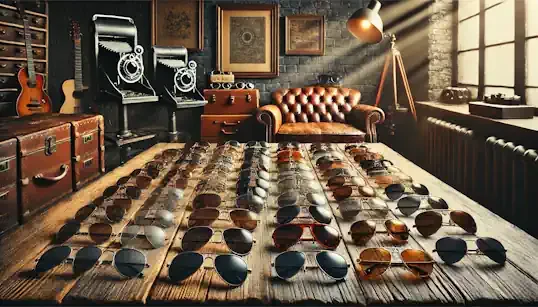Imagine yourself poised at the edge of a windswept airfield, the roar of a radial engine vibrating through the very ground beneath your feet. The scent of leather, oil, and adventure hangs heavy in the air. While few of us will ever experience the raw thrill of piloting a vintage biplane across a boundless sky, we can, however, capture a tangible piece of that exhilarating era. Vintage aviator style is more than just fashion; it's an embodiment of courage, innovation, and a pioneering spirit that continues to resonate deeply today. It's a style forged in the crucible of early flight, born from necessity and refined by a dash of daring panache. This isn't merely about mimicking the past; it’s about connecting with it, owning a fragment of history, and understanding the evolution of a truly iconic aesthetic. For collectors and vintage enthusiasts alike, the world of vintage aviator clothing and accessories offers a treasure trove of timeless style and heritage. This guide will serve as your compass, charting a course through the key pieces, historical context, and essential knowledge needed to navigate the captivating world of vintage aviator collectibles. We’ll explore the evolution of this enduring style, dissect the essential garments and accessories, and equip you with the tools to identify, authenticate, and cherish these remarkable artifacts of a bygone era. Whether you’re a seasoned collector seeking to expand your hangar of historical garments or a newcomer drawn to the romantic allure of flight, prepare to embark on a journey into the captivating skies of vintage aviator style.
The genesis of aviator style is inextricably linked to the very dawn of flight, a period when the idea of conquering the air was still a fantastical dream for most. The late 19th and early 20th centuries were a time of audacious experiments and groundbreaking inventions. Early aviators, those brave souls who first dared to leave the earth, faced a harsh reality: the open cockpit was a brutal environment. Imagine battling bone-chilling winds, the spray of rain, and the relentless bite of cold at altitude, often with rudimentary aircraft offering minimal protection. Necessity became the mother of invention, not only in aircraft design but also in the clothing worn by these pioneers. Early aviator attire was purely functional, designed for survival rather than style. Think of heavy, densely woven fabrics like thick wool and robust leather, chosen for their ability to insulate against the cold and offer some protection against the elements and potential scrapes. Designs were practical and utilitarian; garments were often cinched with belts for a closer fit to minimize wind resistance and featured numerous pockets for essential tools and maps. Key figures from this early period, names like the Wright brothers and Glenn Curtiss, while not explicitly fashion icons, indirectly influenced the early aesthetics of flight through the clothing they wore for practical reasons. Early aviation events, daring air races, and record-breaking attempts captured the public imagination, slowly beginning to weave a romantic narrative around the image of the aviator and their distinctive garb.
The First World War irrevocably transformed aviation and, consequently, the development of aviator style. Military aviation emerged as a crucial element of warfare, demanding standardization and efficiency. The once ragtag group of civilian daredevils was replaced by a structured military force, and with it came standardized uniforms and equipment. This era witnessed the birth of truly iconic pieces that would forever define aviator style. The leather flying jacket, perhaps the quintessential aviator garment, came into its own. Early iterations like the A-1 and subsequently the A-2 jackets were developed for US Army Air Corps pilots, crafted from durable horsehide or goatskin leather, lined with comfortable cotton or wool, and featuring knitted cuffs and waistbands to seal out the cold. These jackets were not just clothing; they were essential pieces of equipment, providing crucial protection in the demanding environment of aerial combat. Goggles, another indispensable item, moved beyond simple eye protection. WWI era goggles were designed for serious functionality, often featuring interchangeable lenses for varying light conditions and robust construction to withstand the rigors of flight and potential impacts. Helmets and flying caps evolved too, shifting from simple leather caps to more structured helmets offering improved protection and often incorporating communication systems – early precursors to headphones. Boots became more rugged and specialized, designed to offer ankle support, warmth, and durability in the confined spaces of cockpits and on rough airfields. The military influence during WWI solidified key elements of aviator style: leather jackets, goggles, helmets, and sturdy boots, all borne from functional necessity but possessing an undeniable rugged appeal.
Following the armistice, the interwar period, often romanticized as the Golden Age of Aviation, saw a fascinating shift. The focus moved from purely military applications to the burgeoning world of commercial and civilian aviation. With this came a subtle but significant evolution in aviator style. While functionality remained paramount, a new emphasis on style and even glamour began to emerge. Lighter, more refined leathers started to replace the heavier hides of wartime jackets. Silhouettes became slightly more streamlined, reflecting a growing awareness of aesthetics alongside practicality. The rise of commercial airlines and civilian pilots, alongside the enduring romanticism of flight, contributed to this stylistic shift. Hollywood and popular culture played a crucial role in solidifying the image of the dashing aviator. Films romanticized flying and the pilots who took to the skies, often portraying them in stylishly rugged leather jackets and goggles, further cementing the aviator look in the public consciousness. This period also saw the emergence of specific brands and styles that became intrinsically linked with aviator fashion. Companies like Aero Leather Clothing and Irvin Airchute Co. gained prominence, producing high-quality flying jackets and gear that were not only functional but also imbued with a certain cachet. The Golden Age of Aviation refined the functional military-inspired style into something more consciously fashionable, blending practicality with an undeniable air of sophistication and adventure.
For the discerning collector venturing into the world of vintage aviator garments, leather flying jackets stand as the undisputed pinnacle, the very embodiment of aviator style. Delving into the specifics of different jacket models is crucial for any serious collector. The US Army Air Corps developed a series of iconic jackets, each with its own distinct history and characteristics. The A-1, introduced in the late 1920s, represents an early stage in the evolution of the leather flight jacket. Typically crafted from goatskin or horsehide, it featured a button-front closure and knitted wool cuffs and waistband. The A-2, its successor, introduced in the early 1930s and famously worn throughout World War II, is perhaps the most iconic of all. Its distinguishing features include a zipper front closure, snap-flap pockets, and shoulder straps, all contributing to its classic silhouette. Variations exist within the A-2 family, reflecting different manufacturers like Rough Wear Clothing Co., Aero Leather Clothing, and Cooper Sportswear, each adding subtle nuances in leather type, stitching, and hardware. Moving into heavier jackets, the B-3 shearling jacket, with its luxurious sheepskin lining and outer, was designed for extreme cold-weather flying, a bulky but incredibly warm garment instantly recognizable for its shearling trim and leather straps. The B-6, a slightly lighter shearling option, offered more flexibility. British counterparts, such as the Irvin jacket, similarly crafted from sheepskin, are equally sought after for their historical significance and distinctive design. When assessing vintage jackets, several factors are paramount. The type of leather – horsehide, goatskin, steerhide, sheepskin – each possesses different qualities and aging characteristics. Stitching quality, meticulously crafted seams, and robust hardware (zippers and snaps) are indicators of original construction. Linings, typically cotton or wool, should be examined for wear and tear. Original labels, often found inside the jacket or in pockets, are crucial for identification and authentication, containing manufacturer information, size details, and sometimes even contract numbers. The overall condition is, of course, a major determinant of value. Collectors often use grading scales ranging from Mint (like new, unworn) to Poor (significant damage). Condition encompasses leather condition (cracking, dryness), zipper and snap functionality, lining integrity, and the presence of any repairs or alterations. Provenance, if available – documentation tracing the jacket’s history and ownership – can significantly enhance its value and desirability, especially if linked to a known pilot or historical event. Grading condition and value are subjective but generally follow established collector guidelines. Rarity, condition, size (larger sizes are often more desirable and harder to find in good condition), and the manufacturer all play a role in determining a jacket’s worth in the collector market.
Goggles, far more than mere eye protection, are another key category for the vintage aviator collector, representing both functional necessity and evolving style. The evolution of goggle design mirrors the progression of aviation itself, from rudimentary shields to sophisticated accessories. Early goggles were simple, designed primarily to protect the eyes from wind and debris. As aircraft speeds increased and altitudes rose, goggles became more specialized. WWI era goggles were robustly constructed, often featuring leather or metal frames and interchangeable lenses to adapt to varying light conditions and altitude. Types of vintage goggles vary widely. Early models might feature simple wire frames and basic lenses. WWI era goggles are typically more substantial, with leather-padded frames and stronger lenses. Interwar styles often incorporated more streamlined designs and stylistic flourishes, reflecting the growing fashion consciousness of the period. Military specifications further dictated goggle design, with specific models designated for different branches of service. Materials and construction are key identifiers. Leather frames, often padded for comfort, are common in early and military goggles. Metal frames, particularly brass or steel, provided durability. Lenses were initially glass, later transitioning to celluloid and eventually acetate. Straps, usually elastic or leather, should be examined for their integrity and original attachment. Key brands and manufacturers to look for include names like Halcyon and Triplex, renowned for their quality and historical significance. When collecting goggles, the condition of the lenses is paramount – scratches, cracks, or clouding can detract from both value and display appeal. Straps should be supple and intact. Frames should be free from significant damage or corrosion. Completeness of sets, especially if they include original boxes or cases, is also a desirable factor for collectors.
Helmets and flying caps complete the quintessential aviator headgear ensemble, offering another fascinating area for collecting. Early leather flying helmets were purely functional, designed to protect the head from cold and impact. As aviation progressed, helmet designs became more sophisticated. WWI and interwar era helmets show significant variations in leather types, often incorporating ear flaps for added warmth and sometimes even rudimentary communication systems, pre-dating modern headphones. Flying caps or soft helmets, often crafted from wool, cotton, or fur-lined materials, provided alternatives for different climates and flying conditions. The distinction between military and civilian helmets is often apparent in their design and markings. Military helmets tend to be more robust and feature standardized designs and markings, while civilian helmets often exhibit more stylistic variation. Collectibility factors for helmets are similar to jackets and goggles. Rarity, condition, and completeness are crucial. Markings, such as military stamps or manufacturer logos, add to their historical value and authenticity. Provenance, if available, can be particularly significant for helmets, connecting them to specific pilots or squadrons.
Boots and footwear are often overlooked but are integral to the complete vintage aviator look and a worthy category for collectors. The functionality of aviator boots was paramount – warmth, ankle support, and durability were essential requirements for pilots operating in demanding conditions. Types of vintage aviator boots include classic leather flying boots, often featuring fur linings for extreme cold, and more general military issue boots that were adapted for flight. Key features and materials include robust leather types, sturdy soles (often rubber or leather), secure closures (buckles, laces, or zippers), and warm linings like sheepskin or wool. Collecting boots can be more challenging than jackets or goggles due to sizing issues and potential wear and tear on soles and linings. When assessing vintage boots, pay close attention to the condition of the leather – look for dryness, cracking, or stiffness. Examine the soles for wear and tear, and check the integrity of the linings, as these are often subject to deterioration over time. Sizing can be problematic with vintage boots, as sizes were not always consistently marked, and finding boots in wearable sizes can be difficult.
Beyond the core garments, a range of accessories completes the vintage aviator aesthetic and offers further avenues for collecting. Scarves, often crafted from silk or wool, were both functional and stylish. Silk scarves were favoured for their smooth texture, preventing chafing and offering a layer of warmth without bulk. Wool scarves provided superior warmth in colder climates. Historically, scarves served practical purposes – protecting the neck from wind and cold, but also becoming a distinctive style element. Pilot’s watches, crucial tools for navigation and timekeeping in the pre-GPS era, are highly collectible. The history of pilot’s watches is rich, with iconic brands like Longines, IWC, and Rolex developing specialized timepieces designed for the rigors of flight. These watches often featured oversized dials for readability, rotating bezels for navigation calculations, and robust construction to withstand vibrations and temperature changes. Vintage aviation maps, flight logs, and photographs offer valuable contextual elements to a collection. These ephemera provide a tangible link to the history of flight, adding depth and richness to a collection beyond just garments. Durable leather luggage and travel bags, designed for the specific needs of pilots travelling between airfields, are another interesting accessory category. These bags often featured robust construction, practical compartments, and a distinctive vintage style.
Equipping yourself with the right collector's toolkit is essential for navigating the world of vintage aviator items. Authentication is paramount to ensure you’re acquiring genuine pieces. Start by scrutinizing labels and markings. Understanding manufacturer labels, military stamps, size tags, and dating codes can provide valuable clues to a garment's authenticity and origin. Familiarize yourself with the label styles and markings of known manufacturers and military contractors from the relevant periods. Analyze construction and materials. Period-correct materials, stitching techniques, and hardware are key indicators. Learn to recognize the types of leather, fabrics, and hardware used in different eras and by different manufacturers. Research resources are invaluable. Books dedicated to military and civilian flight clothing, online databases, collector communities, and museum archives can provide a wealth of information and visual references. Connect with experienced collectors and join online forums dedicated to vintage militaria and aviation collectibles. Learn to recognize red flags that might indicate fakes and reproductions. Be wary of inconsistencies in construction, materials that are not period-correct, and poorly reproduced labels. Modern manufacturing techniques often leave telltale signs that distinguish reproductions from genuine vintage pieces.
Condition assessment is crucial for determining value and making informed collecting decisions. Familiarize yourself with common condition grading scales used by collectors, typically ranging from Mint, Excellent, Very Good, Good, Fair, to Poor. Understand the types of wear and damage common in vintage garments – leather cracking, zipper issues, lining wear, staining, and missing parts. Assess how these imperfections impact the value and desirability of a piece. Distinguish between restoration and preservation. Ethical considerations are important when dealing with vintage items. Restoration, aiming to bring an item back to its original condition, can sometimes diminish historical value if not done carefully and authentically. Preservation, focusing on stabilizing and conserving the item in its current condition, is often a more ethical and collector-preferred approach. When caring for your vintage aviator collection, proper storage is essential. Control temperature and humidity to prevent deterioration of leather and fabrics. Protect items from direct sunlight, which can fade colors and damage materials. Dust protection is crucial – use garment bags or display cases to minimize dust accumulation. Learn appropriate cleaning and conditioning techniques for different materials. Leather care is essential for jackets, helmets, and boots – use specialized leather conditioners sparingly to prevent drying and cracking. Fabric cleaning should be approached cautiously; consult with vintage clothing care experts for advice on cleaning delicate vintage textiles. Consider how you will display your collection. Displaying items safely and attractively not only showcases your collection but also contributes to their long-term preservation. Use appropriate mannequins or archival-quality hangers to support garments properly.
The thrill of the hunt is a significant part of collecting. Knowing where to find vintage aviator gear is key to expanding your collection. Vintage clothing stores and boutiques specializing in vintage and militaria are prime hunting grounds. These stores often curate collections and have knowledgeable staff who can assist you. Online marketplaces like eBay and Etsy offer vast selections of vintage items. However, exercise caution and due diligence when buying online. Carefully examine photographs, read descriptions thoroughly, and check seller feedback before making a purchase. Specialized vintage platforms dedicated to militaria or vintage clothing can also be valuable resources. Antique shows and flea markets can be treasure troves of unexpected finds. These venues offer opportunities for discovery and negotiation, but require patience and a discerning eye. Estate sales and auctions can sometimes yield rare and valuable finds, but require expertise and careful research to avoid overpaying or acquiring misrepresented items. Building connections within the collector community is invaluable. Network with other enthusiasts, join online forums and clubs, and attend collector events. Sharing knowledge, exchanging tips, and learning from experienced collectors is an essential part of the vintage collecting journey.
Vintage aviator style endures because it transcends fleeting fashion trends. Its appeal is rooted in the timeless allure of functionality and style, born from garments designed for a specific and demanding purpose but possessing an undeniable aesthetic appeal. The style evokes a powerful connection to history and adventure, tapping into the romantic and heroic narratives associated with early flight and the brave individuals who first took to the skies. Beyond its aesthetic and historical appeal, vintage aviator gear can also represent investment potential. Certain rare and historically significant pieces can appreciate in value over time, making collecting not only a passion but also potentially a sound investment. Incorporating vintage aviator pieces into a modern wardrobe is about more than just mimicry; it’s about personal expression and adding a touch of timeless cool to contemporary style. A vintage A-2 jacket paired with modern jeans and boots, or a classic aviator scarf adding a touch of panache to a contemporary outfit – these are ways to integrate vintage aviator elements into everyday style while maintaining a modern sensibility. The joy of collecting vintage aviator items lies in more than just acquiring garments; it’s about possessing tangible pieces of history, connecting with the pioneering spirit of early flight, and embracing a style that continues to inspire and captivate. The enduring allure of vintage aviator style is its ability to transport us, if only in spirit, to the wild blue yonder, reminding us of a time when courage, innovation, and style took flight.



